Z77 mITX Round-Up: Five of the Best – MSI, Zotac, ASRock, EVGA and ASUS
by Ian Cutress on December 31, 2012 7:00 AM EST- Posted in
- Motherboards
- MSI
- ASRock
- EVGA
- ZOTAC
- Asus
- Ivy Bridge
- Z77
- mITX
Zotac Z77-ITX WIFI BIOS
Since the inception of a graphical interface for a BIOS, we have had several attitudes towards the design by motherboard manufacturers:
a) Do Nothing
b) Change the colors and reorganize menus
c) Create a different feel, make the changes easier to comprehend
d) Embrace a graphical BIOS and shift the paradigm to an interactive experience
Ideally, we would want all motherboard manufacturers to take to option (d), allowing all users to have a prod and a play with what could be a very interesting interface. Only two experiences I have had ever come close to (d) – the games given in the early MSI P67 BIOSes, and my brief foray into an Intel Z77 BIOS. Apart from this, we are stuck with (a) to (c) for the time being.
For Zotac, writing a novel BIOS can be tough. Zotac is a relatively small player in the motherboard industry with a single-digit percentage in terms of market share, and I would not be surprised if they employed more than a handful of BIOS engineers that actively upgrade the BIOS. If anything, they are more than likely stuck writing code for new models or releasing patches rather than updating. As a result, Zotac fits firmly in the (b) menu of the list above.
Being in the (b) section is not all bad – Biostar have had a fair crack at it in a similar position and have come out with something just about useable but looks nice (as a personal subjective opinion). For Zotac, and this Z77-ITX WiFi, we get a selection of different colored text on a JPEG/PNG style background:
(Apologies for the quality of the images – Zotac are also one of the few motherboard manufacturers without a ‘F12 – Screen to USB’ button which optimizes this part of the review.)
My main issue with a multicolored background stems from my slight level of colorblindness. It deeply affected my ability to select options in an ECS BIOS a few months back, and while it does not affect me here to the same extent, the effect of having white text over a yellow background without a text border can sometimes make text difficult to see. I would chalk this up as a basic design error (like red text on a green background) systemic of an engineer being told to ‘give the BIOS some style’. It certainly has more style than a white-on-black or white-on-blue BIOS of old, but it is not executed as perfectly as one may have imagined.
As for the functionality of the BIOS itself, the main screen above does a good job of informing the user when they enter the BIOS and land on the ‘Main’ page. We get the motherboard model and BIOS version, CPU information and memory size/speed. All that is missing is perhaps a temperature or voltage (or two).
For overclocking, we get the X-Setting menu:
Rather than an endless list of options, Zotac have decided to place overclocking options in separate menus. Everything voltage related gets placed out in this main menu, but frequency settings are partitioned off into separate CPU, iGPU and Memory menus.
A good thing about the Zotac BIOS is that each option has an associated help description in the top right, and each setting will make sense to any user who has overclocked before. Raise the multiplier, perhaps raise the voltage, adjust LLC + power settings as necessary.
Unfortunately there is a little element of confusion in the Zotac BIOS. Some of the CPU overclock settings listed above are duplicated poorly in the Advanced -> CPU Configuration menu. As you can see below, despite the Core Ratio options being part of this menu, they are not configured properly to take into account the values found in the X-Setting section:
In the Advanced menu, we get the usual array of controller options and configuration sub-menus. The important thing to note is the default setting for SATA ports. In 2012 (and for most of 2011) it has become the de-facto standard to make the SATA Mode for the ports to be AHCI as every HDD and SSD sold today can take advantage of AHCI and a new OS is often installed on a newer system. Either Zotac did not get that memo or someone at HQ is not in the loop with modern system construction, because we get IDE as standard. Please make sure you remember to change this on your new build (and each time you might have to clear the CMOS).
Due to the two fan headers on board, we get a small about of fan control in the BIOS:
The fan control allows for a basic type of gradient to be defined, although as shown above the ‘final’ temperature is not possible to be chosen, suggesting that the BIOS uses the TJMax value of the processor to fully ramp up the fan. The system fan header gets a straight forward constant fan speed at the users’ discretion. [Insert my consistent rant regarding fan settings here.]
The last thing to mention in the BIOS is the boot override feature, which is becoming the norm on most motherboards and I am glad to see Zotac use it. With this feature we can select a single device to boot from as a one-time-only situation – useful for booting from USB.


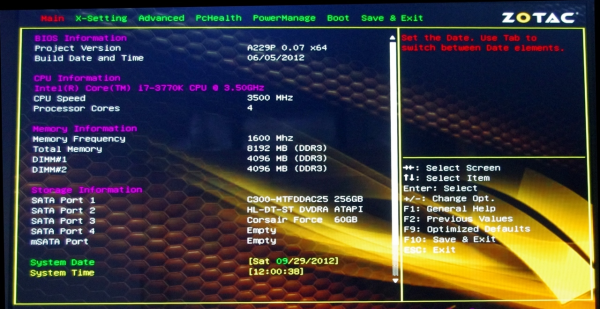

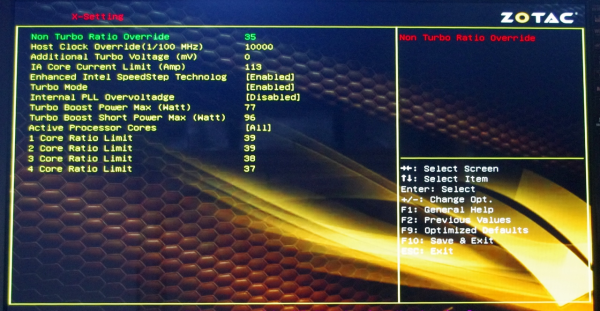
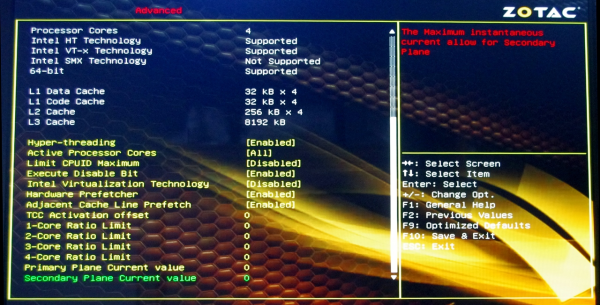
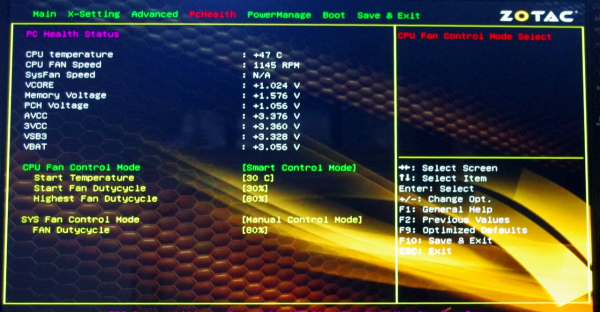
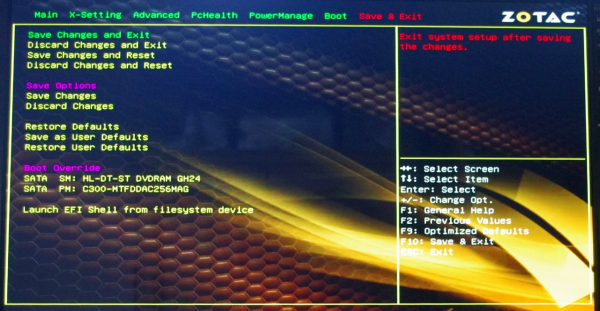














54 Comments
View All Comments
Etern205 - Saturday, January 5, 2013 - link
Here is another model, that supports WiDihttp://www.asus.com/Motherboards/Intel_Socket_1155...
zilexa - Friday, January 11, 2013 - link
Will the upcoming Intel CPUs with integrated GTe graphics chip fit on these mobo's? If so these mITX mobos are VERY futureproof and ideal for an HTPC.doubledd - Wednesday, April 10, 2013 - link
I recently built a mini itx with the MSI Z77IA-53, Cooler Master Elite 120, Antec Kuhler 620, 16gb 1.35V ballistic memory, a 690GTX, a 3570k, default timings and a msata plextor SSD. Except the video card, the system was dirt cheap. With the card, 3D Mark 11 score of X6037.Removal of the HDD cage was all that was required to make room for the radiator to mount to the existing front fan on this $45 case. Folding 100% load processor is 64 degrees....not great, but manageable for this BEAST.
While I consider Anandtech to be one of my trusted sources in reviews, I find it disappointing that they could be reviewing mini itx systems and yet be so out of touch with what people actually use these for. These are lan boxes or HTPCs and are supposed to be small and quiet. Why anyone would want a 8" tall by 8" diameter fan is beyond me. These boards are hardly bigger than a post card. Things are gonna be tight. Think out of the box a bit huh? There are quite a few mini-itx cases that can run or be modded with little effort to run, quiet liquid cooling.
It reminds me of the Consumer reports worst cars of 2013. Half of them are off road vehicles. The complaints are about suspension, shifting and road noise......no kidding?
castl3bravo - Sunday, June 23, 2013 - link
I have found the Asus BIOS for my P8Z77-I Deluxe to be an abysmal mess. My CPU ratio is permanently stuck at 42. During some change of a setting or an upgrade to the latest BIOS, ASUS shoved a "hidden" ME upgrade as well. This process somehow corrupted my BIOS so now I can't overclock beyond ratio of 42.There are other ASUS P8Z77 based m/b's having the same issue. I would suggest Anand have his team research the forums first before writing such glowing reviews of the BIOS for a vendor. I bought this board based on, what appears to be, an inexperienced review last year. Reading this followup on the BIOS is laughable--perhaps even negligent.
Here is but one example of the drama people are going through with this messed up BIOS.:
http://forums.anandtech.com/showthread.php?t=23143...